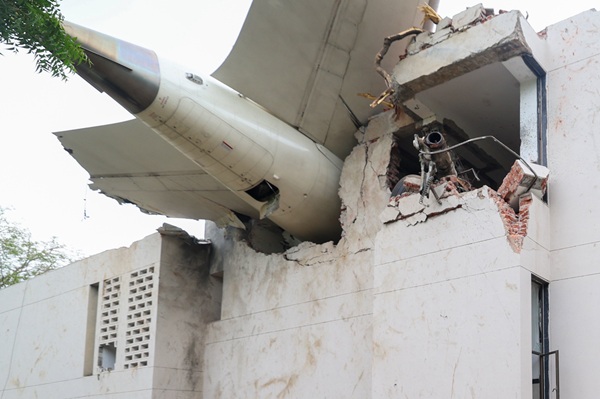.png)

Sanjay Mansabdar teaches finance at Mahindra University in Hyderabad. He brings 30+ years of global experience in derivatives trading and product design, including senior roles at J.P. Morgan, Bank of America, and ICICI Securities.
September 25, 2025 at 6:29 AM IST
Air India 171 should have been another routine flight to Gatwick. Instead, on June 12, 2025, the Boeing 787 lost both engines moments after take-off from Ahmedabad and plunged from the sky, killing 260 people. Three months later, clarity is absent, and doubt only grows. What followed has been no less troubling: an official investigation that appears tentative, inconsistent, and at times, deeply flawed.
Initial reactions from pilots and observers who watched the grainy viral clips of the crash were quick to pin the blame on pilot error — either a mistaken retraction of flaps instead of the landing gear on takeoff, or a failure to deploy flaps.
That theory shifted once audio from the viral video revealed the deployment of the Ram Air Turbine, an auxiliary power source. Its appearance pointed instead to the unthinkable: dual engine failure. With multiple redundancies built into modern aircraft, suspicion now fell on the aircraft itself. Clarity, it seemed, would depend on the Air Accident Investigation Bureau, which had managed to recover the crucial data recorders.
The preliminary report from India’s AAIB, released just within the International Civil Aviation Organization’s one-month deadline, offered few facts and much conjecture. Written with an abundance of “about” and “approximately”, it suggested that a pilot had manually shut off the fuel switches, effectively insinuating suicide and mass murder. Yet no cockpit voice transcripts or detailed flight data were provided. A night-time release of such gravity, issued without hard evidence, was always bound to provoke outrage—and it has.
Alternative Reconstructions
In today’s hyperconnected world, aviation is scrutinised not just by officialdom but by a global network of pilots, engineers, analysts and enthusiasts. Armed with flight simulators, transponder data from Flightradar24, airport surveillance cameras, and an impressive grasp of aircraft kinematics, they have pieced together plausible scenarios that often contrast sharply with the AAIB’s narrative.
Their analyses point to several inconsistencies. The timeline is one. The report suggests that the RAT provided hydraulic power at 47 seconds past the minute, following engine shutdown at 43 and 44 seconds. Yet experts insist the RAT takes six seconds to deliver hydraulic power, implying deployment at 41 seconds, before the alleged switch-off.
Then there is the ADS-B transponder data, which stopped functioning at 51 seconds. Independent data from Flightradar24 shows this aligns with RAT deployment at 41 seconds, as transponders lose power once RAT takes over from the batteries. In short, the sequencing doesnt admit RAT deployment due to causes other than dual engine failure.
Other gaps are glaring. Airspeed data is implausible, claiming a maximum of 180 knots at 42 seconds even as engines were still producing thrust. An accelerating car, for instance, will reach its maximum speed once the foot is taken off the accelerator, not before.
Fourth, smoke visible on CCTV from the left side of the aircraft during liftoff is ignored, though it suggests the presence of fire.
Fifth, the report hints that a pilot mechanically shut fuel switches, concluded by cherry-picking cockpit exchanges. But experts note the recorder can log Boeing 787 fuel switches as “off” during electrical failure without any manual action.
Sixth, and most troublingly, the fire-damaged rear data recorder was housed in an intact tail section and certified to withstand temperatures far beyond those in the fuel fire on impact. Why, then, was it so badly damaged with its data deemed unrecoverable? Clearly a super-hot fire from a different source was present, perhaps that from a runaway thermal event in the rear battery.
Competing Narratives
Against this backdrop, independent reconstructions suggest an alternative story: massive electrical failure, perhaps caused by water ingress in the electrical bay or thermal runaway in the aircraft’s batteries, leading to automatic fuel cut-off, which in turn caused the engines to stop producing thrust. The engines failed not because of pilot sabotage, but because the aircraft systems collapsed. The pilots, far from being culprits, may have acted heroically—cycling switches to restart engines and coming within seconds of saving the aircraft.
If so, the true causes lie elsewhere: in maintenance failings at Air India or design flaws at Boeing. Yet without transparency, speculation is all the public has. The AAIB’s reluctance to release cockpit recordings or full data feeds suspicion that the truth is being obscured. A recent court order termed the report “unfortunate”, but even that fell short of forcing disclosure.
The AAIB narrative is at best shoddy and at worst completely unreliable, putting its credibility under question. Another problematic aspect is that the AAIB investigation team is largely drawn from the Directorate General of Civil Aviation, the very regulator tasked with overseeing airline maintenance. Such dual responsibility undermines confidence. An investigation of this magnitude requires independence, free from the shadow of potential conflicts.
Without independence, there can be no confidence in the investigation. Families are left carrying the cruel suggestion that their loved ones caused the crash. Passengers in India still do not know if Air India maintains its planes properly. And travellers worldwide wonder whether the Dreamliner, the flagship of Boeing’s fleet, is safe.
The ICAO allows a year for a final report, but time is not a luxury in matters of safety and trust. Transparency demands, at the very least, the immediate release of cockpit transcripts and data recorder files. The data should be released now, not after months of a muddled inquiry. What we have instead is an investigation clouded by doubt and a public still in the dark. The greater tragedy would be if the lessons of AI 171 are buried with its victims.




